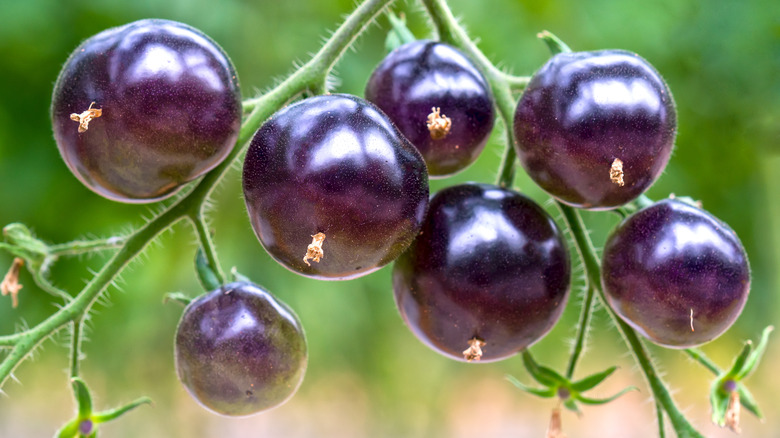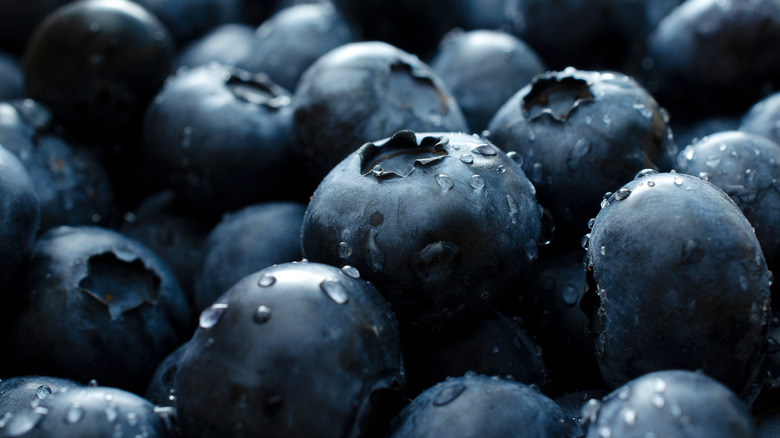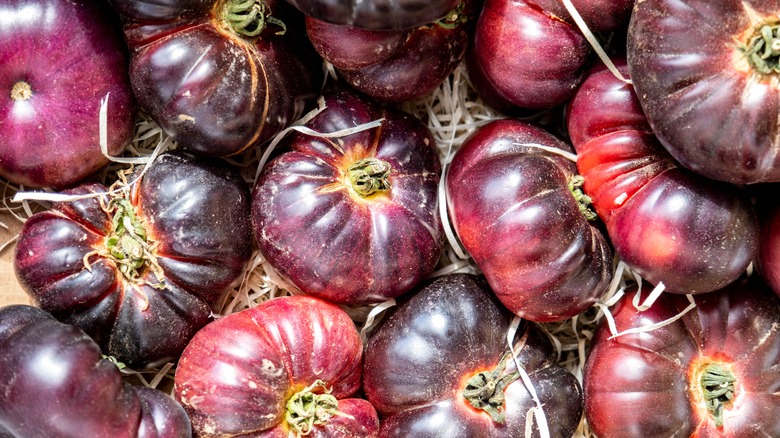The Specially Bred Purple Tomato That's Oddly Similar To Blueberries
Different varieties of tomatoes range from red to orange to yellow, not to mention green when they're not yet ripe. But purple? Thanks to various breeders, that is indeed the case. The Indigo Rose tomato is a 21st-century invention from the scientists at Oregon State University, who selectively crossbred purplish tomatoes to produce offspring with ever cooler, darker hues. The specific pigment that makes a tomato purple and bestows health benefits on those eating it is anthocyanin. Blueberries are also full of anthocyanins, so Indigo Rose tomatoes aren't alone in the fruit world.
In fact, other purple tomatoes exist. Since unveiling circa 2011, Indigo Rose has been joined by the small yet plentiful Indigo Cherry Drops, the sugary Indigo Pear Drops, the resilient-in-the-field Indigo Kiwi, and the saucy Midnight Roma — all from Oregon State University. Seeds of these varieties can currently be purchased online.
Those aforementioned tomatoes don't use genetically modified genes (they were bred using wild tomatoes from Chile and the Galapagos), but GMO purple tomatoes are a thing. One as-of-yet-unnamed purple GMO tomato cultivar is expected to come to the U.S. markets sometime in 2023, thanks to USDA approval, explains New Atlas. It was developed over more than 10 years, using gene editing to make it 10 times as antioxidant as regular tomatoes; borrowing genes from snapdragon fruit, the researchers at Norwich Plant Sciences were able to increase this new tomato's healthy anthocyanin count. Might we suggest "Blueberry-Dupe Tomato" as its official name?
What makes anthocyanins so desirable?
Anthocyanins are healthy antioxidants. However, from an evolutionary standpoint, the reason they manifest in plants is to make them more colorful. There are numerous types of anthocyanins, ranging from red to blue with purple in between. The advantage of such vibrancy is that seed dispersers and pollinators are attracted to these vivid colors. This makes plants with those traits more likely to reproduce and survive as species.
As a result, anthocyanins are found in tomatoes, snapdragons, and blueberries, but also beets, cornflowers, dahlias, red cabbage, and roses. They're also responsible for turning leaves reddish-purple in autumn, when green chlorophyll fades away. Even flies and some other bugs sometimes produce anthocyanins.
For those of us eating rather than producing anthocyanins, though, the benefit is in their medicinal value. According to Verywell Health, the antioxidant properties of anthocyanins could lower the risk of cell damage and diseases such as Alzheimer's, diabetes, cancer, glaucoma, and heart disease, just to name a few. Some unproven claims further suggest anthocyanins can combat inflammation while also making people more resistant to viral infection. At this point in time, anthocyanins are viewed by the medical community as supplemental. Still, there seem to be few downsides and many potential upsides, so some individuals eat blueberries every day to get their anthocyanin fix. Now, they can add purple tomatoes to the mix.
Heirloom tomatoes also appear purple
If you're familiar with heirloom tomatoes, you might be scratching your head and asking yourself, "Didn't purple tomatoes already exist?" And indeed they did, in the form of certain heirloom tomatoes, including the Black Cherry, Black Krim, and Black Prince varieties. However, the pigment responsible for their purple coloring is not anthocyanin but pheophytin, which lacks antioxidant health benefits.
Heirloom tomatoes aren't GMOs, nor are they cross-pollinated. Instead of being commercially grown, they tend to be sold at farmers' markets, where gardeners can show off their specialized strains of the crop. Like family recipes, they're typically unique and passed down through generations, maintaining distinct flavors, physiques, and sizes. Heirloom tomatoes are also fragile and particularly perishable due to the lack of genetic modification.
One of the most famous heirloom tomatoes, the Cherokee Purple, for example, is purple, green, and brown; it tastes savory, smoky, sour, and sweet. It's named as such because it was purportedly grown by the Cherokee people in the past. However, its seeds' oldest confirmed origin point is a Tennessean neighborhood garden. Because the Cherokee Purple tomato is a resilient crop and delicious vegetable, it's become popular in culinary circles. Nevertheless, as an heirloom tomato, the Cherokee Purple does not have the healthy amounts of antioxidant anthocyanins that the blueberry-esque Indigo Rose tomato does.


